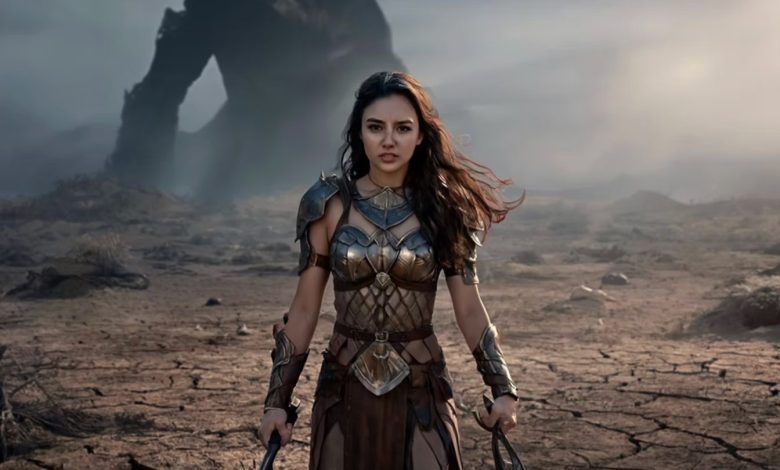At MIPCOM, AI Wasn’t a Threat — It Was an Opportunity

“You can call it slop all you want, it’s pretty cool.”
Sean Atkins, CEO of creator-led video production company Dhar Mann Studios, was talking on MIPCOM Cannes’ main stage on Tuesday about the release of Sora 2. The latest piece of futuristic tech from Sam Altman’s OpenAI, Sora 2 is a TikTok-style text-to-video app that allows users to conjure up whatever they want, and will even let people scan their face to place themselves in hyperrealistic clips. The product’s release immediately panicked Hollywood, but at MIPCOM, the 41-year-old TV market held annually in Cannes, it was cause for celebration.
“I’m an optimist,” Atkins added at his headliner session, “so I’m not necessarily worried about [AI] long-term, but I think there’s some near-term pain we’re all gonna have to put up with.” The former MTV president said Dhar Mann Studios — featured in The Hollywood Reporter‘s latest cover story on YouTube’s world domination — uses artificial intelligence in their production flow.
It was a MIPCOM entirely dedicated to the creator economy, with YouTube stealing the spotlight from day one. In between all the keynote sessions, panels and showcases on creator content, however, was the next big disruptor for the film and TV industry, flying ever-so-slightly under the radar: “Monetizing Content in the Age of AI,” “Next in AI” and “Nurturing Future Creative Leaders with AI” were among the events on the lineup this year, as well as sessions with full-time AI artists on how to integrate the tech into your content.
The general consensus among industry execs is that any hopes of fending off the AI boom are long dead — and the work to accommodate it has already been done. “Before doing AI, we had to fix the plumbing and build the right tech infrastructure,” Damien Viel, Banijay‘s chief digital & innovation officer, tells THR on the ground in Cannes. “Because if you want to get AI empowered in your company, you need to get data, you need to get your infrastructure organized and you need to build AI platform.”
Viel explains that any “plumbing” work extends to the legal framework at Banijay too, with 130+ production companies in need of a code of conduct over the tech and a whole lot of transparency. It’s taken the content powerhouse two years to get the infrastructure in place. Now come the team-ups: “We are super optimistic for this MIP because we’ve done the plumbing, and now we can come and talk to platforms like YouTube and say, ‘We are ready to start collaborating with you.’”
One of the most visible uses of AI for a company like Banijay is clipping tools — applications that use artificial intelligence to automatically identify and extract compelling moments from longer videos, transforming them into short clips that can be easily shared. “We’ve put 200,000 hours of content on the cloud,” says Viel, “and we have indexed this content to make it searchable, clippable and with the right languages.” The tool will even allow searches based on the emotions AI has detected in the videos.
It’s not long before the Frenchman also brings Sora 2 into the conversation, a platform he believes will help his company wade through the most pressing problem in TV right now: consumer centricity. “Sora 2 is an opportunity because now, finally, we can get videos that are longer than two, three, four minutes — we can now go to five, seven and eight, and that’s going to be changing the way we operate. But more importantly,” says Viel, “what Sora 2 is [doing] is bringing a new way of consuming content with an app or social media.”
For the Banijay exec, it’s not so much about what the final result is, but what Sora 2 will demonstrate about the wants of audiences. He discusses Banijay’s newly-launched partnership with YouTube, the Creators Lab, where selected YouTube stars are to be given €50,000 ($58,000) to inject new life into the company’s dormant TV formats. “The principle of this lab with YouTube is we are not only finding a way to finally collaborate with creators, we’re also trying to learn from them,” says Viel. “What they’re using, how they’re so effective, and how we can build together the entertainment that’s [put] on in the living room in the next one or two years.”
This kind of exploration into consumer appetite is what AI is now permitting at big studios, adds the Banijay chief. “Having a full movie generated by AI? It’s already done… But this is not the way we can be more creative. We will be more creative the day we perfectly understand what these users want to watch and how we can bring them into this experience.”
Can Viel imagine a world in which one of Banijay’s 130 or so production companies would hire an AI “actress” like Tilly Norwood in a lead role in a TV show? “I don’t think the machine is, right now, the best-equipped in terms of sentiment,” he responds. “I think that the challenge we have is to keep creativity and human sentiments in everything we do. But,” he adds, “we’ve got tools that help us detect new sentiments. We can [use AI] to extract content that we’ve already made and produced.”
Frenzy around the news that talent agencies were looking to sign Norwood has now seemingly died down. “It has no life experience to draw from, no emotion and, from what we’ve seen, audiences aren’t interested in watching computer-generated content untethered from the human experience,” read a scathing statement from SAG-AFTRA about Norwood and its creator, Eline Van der Velden’s Particle 6 Productions. “It doesn’t solve any ‘problem’ — it creates the problem of using stolen performances to put actors out of work, jeopardizing performer livelihoods and devaluing human artistry.”
The widespread outrage from actors, filmmakers and labor unions over computer-generated talent hasn’t stopped the jokes rolling in on social media and beyond. “I remember watching [Saturday Night Live] in the ’70s,” said Amy Poehler during her Oct. 11 SNL hosting gig. “Sitting in my house in Burlington, Massachusetts, thinking, ‘I wanna be an actress someday, at least until they invent an AI actress who’s funnier and willing to do full frontal.’”
Though Tilly Norwood has, as an emblem of what the future could hold, been met with fury across the board, AI talent was actually up for grabs at MIPCOM. One session titled “Freedom Reimagined: AI, Vertical Drama & the Turkish Wave” debuted a trailer for what Vitpepper Studios has dubbed the world’s first series entirely generated by artificial intelligence. Tesseract, following a woman named Laila who embarks on a search through alternate realities for her missing child, boasts six episodes.
Pamir Güroğlu, chief growth officer & partner at Vitpepper Studios, and Erim Şişman, film director, scriptwriter, and director of AI Studio at Vitpepper, took to the MIP Creative Hub to premiere the trailer to the international market. “As the debate heats up and the technology evolves super fast… I think we should maybe show what the future looks like,” began Güroğlu. “Because AI takes it a step further and shows what’s merging with human creativity and the capabilities of technology — how it enables the human imagination. So we would love to show you what the future looks like, and I would love to present the teaser of Tesseract, our first 100 percent fully AI-generated series.”
Tesseract, a vertical drama produced in the English language, stars “digitally-cloned real actors” and Turkey’s first AI “actor” İz. It was hailed as the pinnacle of innovation at Vitpepper’s MIPCOM session, and yet, buzz surrounding the trailer was minimal. The YouTube hysteria proved an almighty distraction.
AI sessions at the Palais this year seemed to suggest that workflow uses of artificial intelligence are already in practice at all of the major studios and production companies — not yet a threat to jobs but efficient and economical. And while the much grander, bolder AI content (such as Tesseract) remains experimental, it is officially out there: under our noses, in front of buyers and given stage time at the busiest TV market in the world.
Said Atkins at his headliner session: “There’s three things required for any creative [endeavor] whether we’re talking poetry, speech-writing, screenplays, painting: you have to have a vision. You have to have the will and effort to do it… And you have to have the means. AI is not changing if someone has the vision. It’s not changing [the effort]. It’s changing the means.”
Source: Hollywoodreporter
HiCelebNews online magazine publishes interesting content every day in the TV section of the entertainment category. Follow us to read the latest news.





